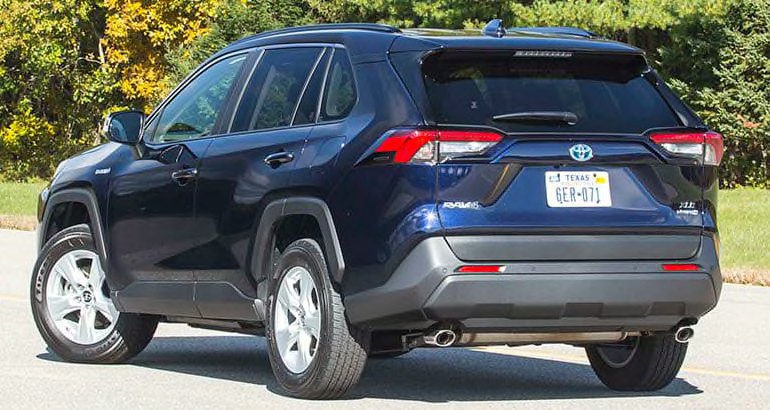Update: Since this first drive was originally published in November 2018, we have posted a complete Toyota RAV4 road test.
The original Toyota RAV4 pioneered the small, car-based SUV segment in the mid-1990s, inspiring a legion of imitators over the years.
Today, these so-called crossover vehicles are dominating sales in America, with their blend of available all-wheel drive, elevated ride height, decent fuel economy, maneuverable size, and versatility.
The RAV4 sells a stunning 400,000 units per year—and has sold well for many years—making the stakes gargantuan for Toyota with this redesign. It is no surprise, then, that the company focused on preserving the model's core virtues with the latest version, while aiming to expand its appeal.
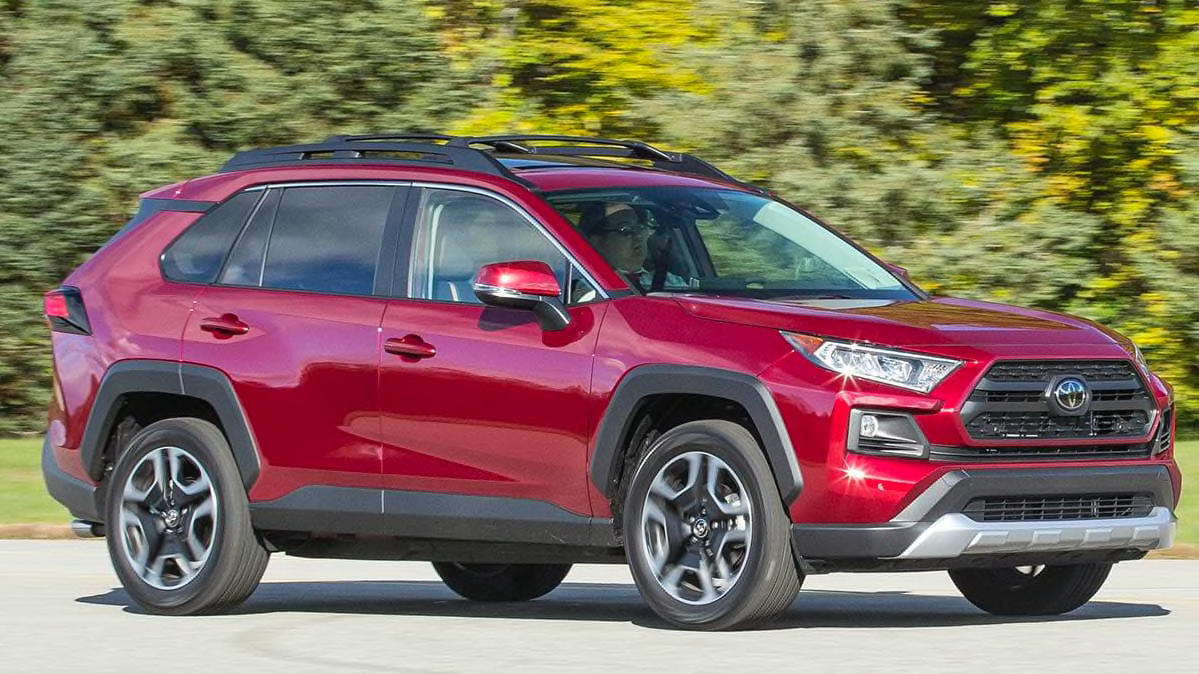
The most noticeable facet of the new RAV4 is the more angular, daresay aggressive, styling. It looks like inspiration was drawn from the Tacoma pickup truck's grille, the Prius Prime's dramatic fog lamps, and the 4Runner's squared-off wheel arches. The look is made more striking by a slight shift in proportions, with the 2019 RAV4 being incrementally shorter, wider, and lower than its predecessor. The combined effect is a declaration that this is a truly new machine.
We rented a RAV4 Adventure and a RAV4 XLE Hybrid to gather our first impressions of this significant new model. We will purchase our own RAV4 to test once it goes on sale in December. The hybrid arrives in early 2019.
What we drove: 2019 Toyota RAV4 Adventure AWD and RAV4 XLE Hybrid AWD.
Powertrain: Toyota estimates: 203 hp (Adventure) and 219 hp (Hybrid). Both: 2.5-liter four-cylinder engine; eight-speed automatic transmission; all-wheel drive.
Pricing: $29,500, XLE Hybrid; $32,900, Adventure.
Destination: $1,045.
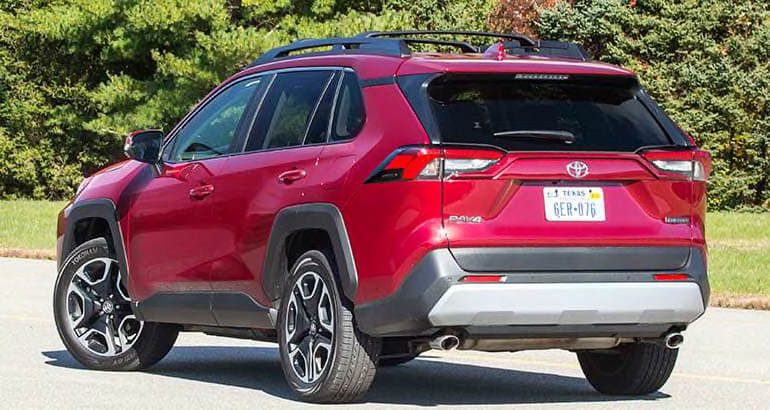
Overview
The RAV4 has been reinvented, with slight changes in dimensions having a significant impact on how the SUV feels. The changes bring more personality, which could broaden the popular model's appeal, especially with the Adventure trim level. There were some rough edges with the preproduction models we drove, however.
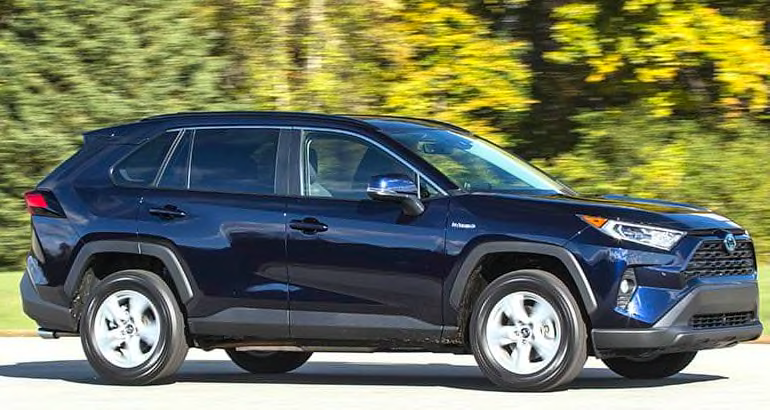
How It Drives
This RAV4 feels bigger and more substantial on the road than its predecessor. The ride is better than before, being more taut and controlled. The steering is improved, providing a bit more welcome feedback to drivers. Moreover, its handling is helped by its reduced leaning in turns.
The preproduction models exhibited more noise than previous engines did, and some shifts weren't as polished as they should be. We hope these rough edges are smoothed on the road to production.
The standard 2.5-liter, four-cylinder engine is paired with an eight-speed automatic transmission and gets about 27 hp more than the 2018 RAV4. It is interesting that Toyota chose not to offer a turbo engine or continuously variable transmission when most key rivals are turning to such a combination for greater power and efficiency.
The more powerful hybrid feels energetic, with the electric drive producing a more immediate feel from a standstill.
As before, front- and all-wheel drive versions are available. Adding to its bag of tricks, nonhybrid RAV4s with AWD have a new Multi-Terrain Select system which allows the driver to select traction modes for snow, mud, and sand, and rock and dirt. Ground clearance has been increased by a half-inch, further adding to the RAV4's light off-road credentials.
Toyota estimates that the regular RAV4 will deliver 29 to 30 mpg overall and that the hybrid will return 39 mpg overall. Both sets of numbers are impressive. We observed 26 mpg and 38 mpg, respectively.
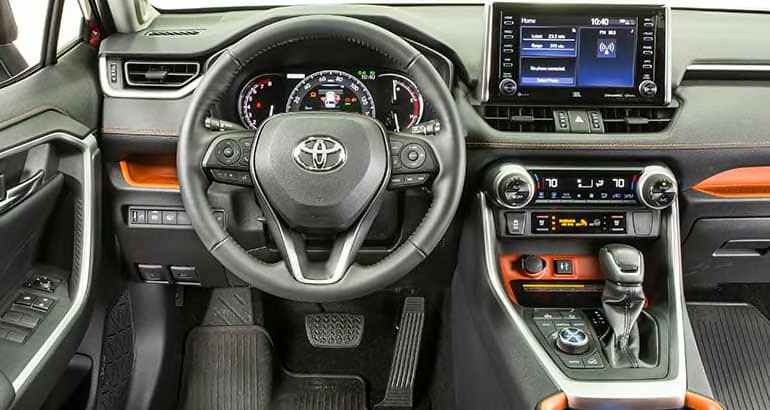
Inside
Increased ground clearance makes it more difficult to get into the RAV4; riders will need to step up and over the lower door sill. Further, the sharp angle to the windshield pillar, sloped B-pillar behind the driver's door, and limited opening range for the front doors create an entry challenge that doesn't exist on popular competitors. Getting in on the passenger side may be difficult for some because the seat height can't be adjusted. The tale of the measuring tape shows that the opening is smaller than that on the Subaru Forester, with about 4 inches less entry height for the driver.
Once inside, we found the seats to be one of the most significant improvements over the last model. It's now easier to get a power seat with lumbar support without opting for the high-end Limited trim.
There are large, clear controls for most functions, though there are tiny buttons around the infotainment screen, as we have noted on the Corolla hatchback. Those little Tic Tac-sized buttons can be hard to see in the sun, when glare can make it difficult to read the labels.
The infotainment system is finally Apple CarPlay compatible, and every RAV4 has built-in WiFi via Verizon and Amazon Alexa digital assistant. A Qi wireless phone charger is available.
The RAV4 is available with a digital rearview mirror that uses a video display to reveal what's behind the SUV, rather than just a mirror that can be blocked by passengers, head restraints, or cargo. That video view takes some getting used to, and objects may seem farther away than they actually are. A 360-degree bird's-eye view is also available as an upgrade from the backup camera—a nice convenience and safety aid when parking.
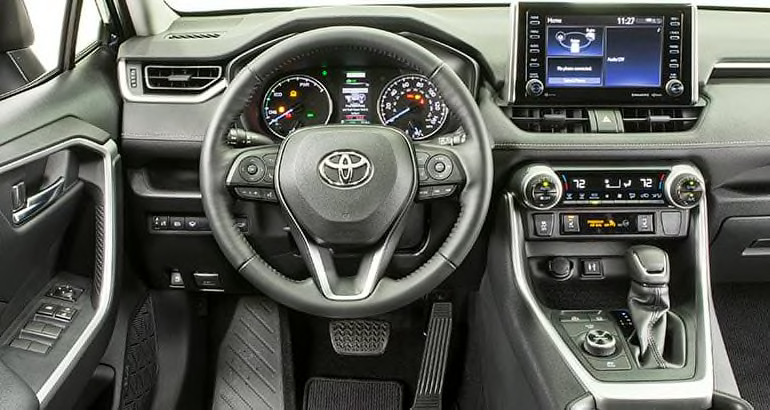
The XLE's interior trim feels a bit bland. We noticed that the few colored trim pieces and seat stitching that come as part of the Adventure trim added some much-needed visual flair.
Thin front pillars with small sail windows help the view out the front, and there is good rear side visibility—something not to be taken for granted.
The back seat sits a bit low, causing riders' knees to be high. Legroom is plentiful, although thigh support is limited and headroom merely adequate. The seatbacks recline for comfort. The LATCH anchors for securing car seats are particularly easy to use. The rear seat is split into two sections: one that's about 60 percent of the backseat width, and the other about 40 percent of it. But it doesn't quite fold flat for transporting large objects.
Drivers can activate the powered rear hatch by waving a foot below the rear bumper—that's helpful when drivers approach the vehicle with an armload of groceries. The rear cargo opening is exceptionally wide, making it easy to load large items. There is additional space under the cargo floor. A retractable cargo cover can fit under the floor.
Safety and Driver-Assist Systems
The RAV4 comes with the second-generation Toyota Safety Sense safety suite. This includes forward collision warning with pedestrian detection, automatic emergency braking, lane departure warning, lane keeping assist, adaptive cruise control, and road sign recognition. Note that blind spot warning and rear cross traffic alert are optional.
CR's Take
The redesigned RAV4 has more attitude, from its more extroverted styling to its gains in power and technology. This move helps distinguish it from a crowded field, especially with the new Adventure trim. But there are some critical weaknesses, as reported in our road test.
See the complete Toyota RAV4 road test.
